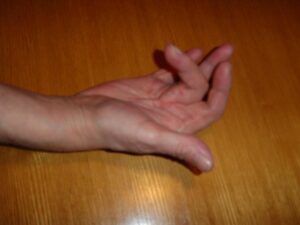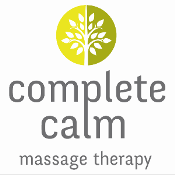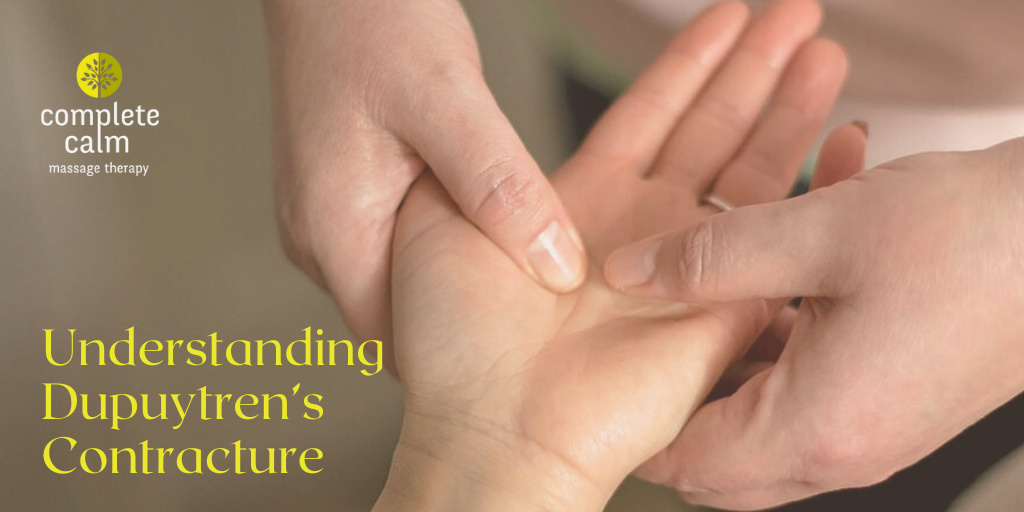Dupuytren’s Contracture is a condition where the connective tissue in the palm thickens, forming tight cords that pull the fingers toward the palm. While there’s no cure, specialised techniques, including massage and manual therapy, can help maintain mobility, improve comfort, and manage associated tension in the hand, arm, and even the upper body.
Imagine the connective tissue in your palm is like a stretchy fabric that helps your hand move smoothly. With Dupuytren’s Contracture, this fabric starts to thicken and tighten, forming little knots or cords under the skin. Over time, these cords pull your fingers (usually the ring and little fingers) inward toward your palm, making it hard to straighten them.
Why does it happen?
The exact reason isn’t clear, but it’s thought to run in families and is more common in Northern Europeans. It tends to appear in midlife and beyond, and while it’s not painful for most, it can make everyday tasks like shaking hands, holding objects, or even putting on gloves more difficult.
What can be done?
Dupuytren’s Contracture doesn’t usually go away on its own, but there are ways to manage it. In the early stages, just keeping an eye on it is sometimes enough. If it starts to interfere with hand function, treatments like injections, minimally invasive procedures, or surgery can help straighten the fingers.
Can massage help?
While massage won’t stop or reverse Dupuytren’s, it can be useful for keeping the rest of the hand and arm muscles relaxed and mobile. A massage therapist can also help reduce tension in areas that might be compensating for the stiffness in your fingers.
Therapeutic massage doesn’t just focus on the hand and forearm; it also considers how trigger points and tension in surrounding areas, such ad the back, shoulders, and chest, can contribute to pain and restriction.
Relaxation and warming the tissues:
Effleurage (gentle stroking) is used to warm the tissues and promote relaxation. This helps prepare the hand, wrist, and forearm for deeper work.
- Addressing the upper back and shoulders:
The upper back and rotator cuff muscles are treated using effleurage and petrissage to reduce tension and deactivate trigger points.
Trigger points in the latissimus dorsi and serratus anterior are also treated, as these can refer pain into the palm and hand.
- Treating the hand, forearm, and wrist:
The flexor and extensor muscles of the forearm are treated with deeper techniques like kneading (petrissage), skin rolling, and muscle-stripping to release tension.
Trigger points in these muscles are addressed to prevent shortening or referral pain patterns.
Deeper kneading focuses on the palmar surface of the hand, progressing from the wrist toward the finger bases (metacarpophalangeal joints). Fascial techniques are applied to reduce contractures and improve tissue pliability.
Friction techniques target adhesions in the palmar fascia and around tendons, followed by icing to reduce inflammation.
- Stretching and mobilising the joints:
Massage techniques are combined with passive joint extensions, progressing to slow, passive extensions of the affected joints. Each part of the finger will be stabilised and mobilised to safely stretch the contractures without tearing the tissue. This process is followed by passive relaxed extension of the wrist and elbow. - Focusing on the chest and neck:
Then on turning face up, the pectoralis major and pectoralis minor are treated, as these muscles often develop trigger points that refer pain into the arm and hand.
trigger points in the scalenes (neck muscles) on the affected side are treated, as these too can refer pain down the arm.
The cervical spine (neck area) and the unaffected arm are also massaged, ensuring overall balance and relief from compensatory tension.
- Finally:
The session concludes with repetitive stroking (effleurage) of the arm to soothe tissues and promote circulation.
Contrast hydrotherapy (alternating warm and cool applications) is applied to the arm to further enhance blood flow and recovery.
Why is this holistic approach helpful?
By addressing the hand, arm, chest, and back, this treatment not only targets the areas affected by Dupuytren’s but also prevents pain and dysfunction from developing elsewhere. Trigger points in the upper body (such as the latissimus dorsi, serratus anterior, pectorals, and scalenes) can all refer pain into the arm and palm, so releasing them can reduce overall discomfort and improve mobility.
Reference: Clinical Massage Therapy: Understanding, Assessing and Treating Over 70 Conditions by Fiona Scott Rattray, Linda Ludwig


Recent Comments